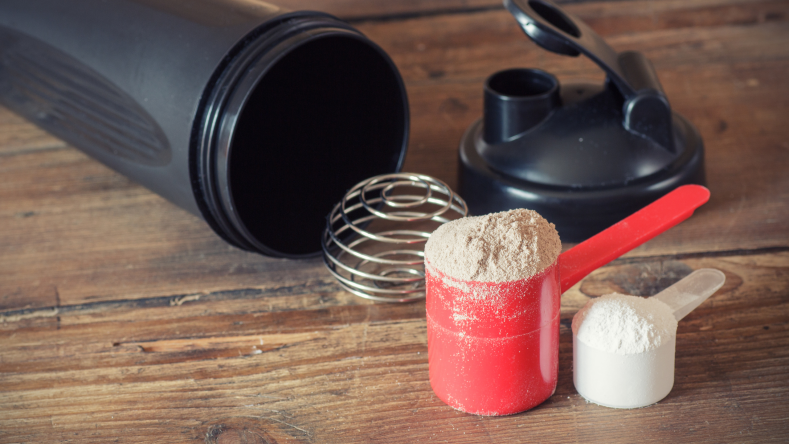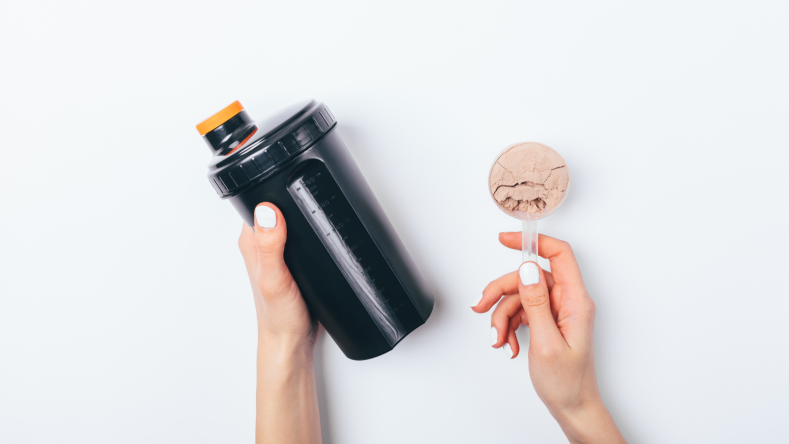Whey protein vs. plant based protein powder: what’s the difference?
Protein powder is often seen as a convenient supplement option to help boost performance, aid in weight loss, and speed up recovery. But with so many options on the market, how do you know which one is best? Here are the main differences between whey protein and plant based protein powder.

Let’s be honest–it can be hard to beat a good protein shake, especially if you’re looking to get more protein into your diet, supplement extra gains in the gym or drop a few pounds. This convenient source of nutrition has long been praised by athletes and recreational gym-goers alike for its convenient role in building lean muscle mass, improving strength, and promoting tissue repair.
But with so many protein powder options available on the market these days, how do you know which one is best for you and your needs? Here's what science has to say about the differences between whey protein and vegan protein powder.

What is whey protein?
Whey protein is one of the primary proteins found in dairy foods, and is considered a complete protein, as it contains all of the essential 9 amino acids. Furthermore, it is highly digestible, rapidly absorbed, offers around 25 g of protein/serving and is rich in leucine (which helps kick start muscle repair and growth) [ 1
Another protein found in dairy products is casein protein, which provides your body with a slow, steady release of amino acids. This makes it ideal for fasting situations (such as while you sleep), weight loss (as it promotes satiety), and muscle growth. Casein differs from whey protein in the fact that whey is more rapidly absorbed, hence may be more useful after a workout.
Some additional benefits of whey protein include:
Lower blood pressure. Studies have found that whey protein may help lower blood pressure in pre-hypertensive adults [
2
].More stable blood sugar. Whey protein can moderate blood sugar levels when taken before a high-carbohydrate meal and may therefore be beneficial for those with type 2 diabetes [
3
].Lower cholesterol levels. Whey protein may be supportive of heart health, especially among those who are overweight or obese, as research has found that high doses of whey protein can help reduce cholesterol levels and improve lipids over time [
4
,21
,22
].
Does whey protein cause acne?
Despite some cases reporting that whey protein causes acne, there isn’t enough compelling evidence to suggest a correlation between the two. Much of the research done is on very small samples of the population [ 5 6
While whey protein may not directly cause acne, there might be other reasons as to why your skin is breaking out. Some common contributing factors to consider may include oily skin, humid environments, hormonal disruptions, poor sleep, obesity, and high fat and high sugar diets [ 7
Whey isolate protein powder
The difference between whey protein and whey isolate protein powder is that the latter undergoes more processing, which results in a higher protein content with less carbs, lactose and fat, which have been filtered out [ 8
How much whey protein per day?
According to the Recommended Dietary Allowance (RDA) for protein needs, you need at least 0.8 g of protein/kg of body weight/day to meet the body’s most fundamental nutritional needs (like repairing tissue, coordinating bodily functions, maintaining pH levels, and allowing metabolic reactions) [ 9 10
These numbers may vary depending on your activity level, age, and other needs, so talk with a dietitian or your healthcare provider to see what is right for you.
While you can obtain protein through dietary sources (like eggs, dairy, lean meat, poultry, fish, beans, lentils, soybeans, or tofu), whey protein powders may also be convenient and beneficial for meeting your nutritional needs.
However, excessive consumption of whey protein may cause digestive problems (such as nausea, bloating, cramping, flatulence, and diarrhea), so be cautious of how much you consume.
When to take whey protein
When you should take whey protein depends on your health and performance goals.
Muscle repair and recovery. It’s recommended to drink protein shakes within two hours of exercise. According to the International Society of Sports Nutrition, consuming 20-40 g of high-quality protein with leucine (like quick-digesting whey protein) shortly after exercise stimulates robust increases in muscle protein synthesis that can benefit both performance and recovery [
11
].Weight loss. Research suggests consuming 25-30 g of quality protein at breakfast, lunch, and dinner may benefit weight loss by improving energy metabolism, protein synthesis, and appetite control [
12
]. If you’re trying to lose weight and are not getting at least 25-30 g of protein at breakfast, drinking a whey protein shake in the morning may help your weight loss efforts.
Does whey protein expire?
When stored in a dry, cool spot, whey protein powder has a shelf life of 9-18 months [ 13 14

Vegan protein powder
If you’re a vegetarian, vegan, or have a dairy allergy, you may want to consider some different options for protein supplementation. Here are some of the most common types of plant based protein powders.
Soy protein powder
Soy is a complete protein and aids in muscle building. It contains leucine (a branched-chain amino acid, or BCAA) to enhance muscle protein synthesis; however, studies have found that both whey and casein may be superior in this respect [ 15
Soy protein comes from the protein found in soybeans [ 23 24
With 23 g of protein/serving, soy can serve as a good source of protein for those who have a dairy allergy or follow a vegetarian or vegan diet.
Interestingly, emerging evidence suggests that combining dairy and soy protein may result in greater muscle protein synthesis than if you were to consume each one separately, though we’ll need further research in humans to have more conclusive evidence [ 16
Hemp protein powder
Just like whey and soy, hemp protein is also considered a complete protein, as it has all 9 essential amino acids. Additionally, it’s easy to digest, and has 15 g of protein and 8 g of fiber/serving, making this a good option for those with dairy allergies or who follow a plant-based diet [ 17
Hemp protein powder is made by grinding pressed hemp seeds into a fine powder. The seeds are taken from the whole hemp seed meal that has had the oil removed [ 25
Pea protein powder
Coming in at 15 g of protein/serving, pea protein is another good vegan protein powder option.
Not only is it rich in BCAAs, but it also contains arginine and leucine to promote healthy blood flow, muscle growth, and protein synthesis [ 18
Pea protein powder is made by isolating the protein from ground yellow peas [ 26
One study showed that active men who took pea protein powder experienced a greater increase in bicep muscle thickness than those who had whey protein [ 19 20
Which option is best?
Whey protein and vegan protein powders are all good options when it comes to supplementation. Research supports both for performance improvements and meeting your daily protein needs. You may want to consider the other ingredients in the powder as well, especially if you have allergies or intolerances. Ultimately, the best choice for you is one that is accessible, fits your eating style and makes you feel your best.
Some protein powders also contain additional vitamins and minerals, such as iron, B Vitamins and more. Check with your healthcare provider or dietitian to see if these are recommended for you and your health goals.
Precautions
Despite the benefits, there are potential risks associated with protein powder. It’s considered to be a supplement (which means that it’s not regulated by the FDA), and some may contain possible contaminants like arsenic, cadmium, mercury, and lead [ 27 28
Furthermore, some protein powders may contain added sugars (which might increase the risk of chronic disease) and artificial sweeteners (like aspartame, acesulfame-K, and sucralose) that have been correlated with an increased risk of cancer [ 29 30
FAQs on protein powder
Hungry for more? Check out these nutrition FAQs on protein powder.
Should you drink a
protein shake before or after workout
?
Summary
Protein powder has long been praised by athletes and recreational gym-goers alike for its role in building lean muscle mass, improving strength, and promoting tissue repair. But with so many protein powder options on the market, it can be hard to sort through the noise to decide which one works best for you and your needs.
Whey protein (dairy-based) and vegan protein (like soy, hemp, and pea) are the two main categories when it comes to protein powders. While they are all good protein supplement options, the best choice for you is the one that fits your eating style and makes you feel your best.
Disclaimer: The text, images, videos, and other media on this page are provided for informational purposes only and are not intended to treat, diagnose or replace personalized medical care.
Key takeaways
Whey protein is one of the primary proteins found in dairy, and is considered a complete protein, as it contains all of the 9 essential amino acids. It also offers around 25 g of protein/serving.
Compared to casein protein (another protein found in dairy), whey protein is quickly digested.
Studies have found that whey protein may help lower blood pressure, moderate blood sugar levels, and support heart health [
2
,3
,4
].With 23 g of protein/serving, soy protein can serve as a good source of protein for those who have a dairy allergy or follow a vegetarian or vegan diet.
Hemp protein is considered a complete protein, is easy to digest, and has 15 g of protein and 8 g of fiber/serving.
Pea protein is rich in BCAAs, and contains arginine and leucine to promote healthy blood flow, muscle growth, and protein synthesis. It also offers 15 g of protein/serving.
When choosing a protein powder, consider the other ingredients and additives that may be added. Choose one that best fits your lifestyle and eating habits, and that makes you feel your best.
References
Hamarsland, H., Nordengen, A. L., Nyvik Aas, S., Holte, K., Garthe, I., Paulsen, G., Cotter, M., Børsheim, E., Benestad, H. B., & Raastad, T. (2017). Native whey protein with high levels of leucine results in similar post-exercise muscular anabolic responses as regular whey protein: A randomized controlled trial. Journal of the International Society of Sports Nutrition, 14(1).
https://doi.org/10.1186/s12970-017-0202-y
Yang, J., Wang, H. P., Tong, X., Li, Z. N., Xu, J. Y., Zhou, L., Zhou, B. Y., & Qin, L. Q. (2019). Effect of whey protein on blood pressure in pre- and mildly hypertensive adults: A randomized controlled study. Food science & nutrition, 7(5), 1857–1864.
https://doi.org/10.1002/fsn3.1040
Mignone, L. E., Wu, T., Horowitz, M., & Rayner, C. K. (2015). Whey protein: The "whey" forward for treatment of type 2 diabetes?. World journal of diabetes, 6(14), 1274–1284.
https://doi.org/10.4239/wjd.v6.i14.1274
Tahavorgar, A., Vafa, M., Shidfar, F., Gohari, M., & Heydari, I. (2015). Beneficial effects of whey protein preloads on some cardiovascular diseases risk factors of overweight and obese men are stronger than soy protein preloads – a randomized clinical trial. Journal of Nutrition & Intermediary Metabolism, 2(3-4), 69–75.
https://doi.org/10.1016/j.jnim.2015.08.002
Simonart T. (2012). Acne and whey protein supplementation among bodybuilders. Dermatology (Basel, Switzerland), 225(3), 256–258.
https://doi.org/10.1159/000345102
Silverberg N. B. (2012). Whey protein precipitating moderate to severe acne flares in 5 teenaged athletes. Cutis, 90(2), 70–72.
Yang, J., Yang, H., Xu, A., & He, L. (2020). A Review of Advancement on Influencing Factors of Acne: An Emphasis on Environment Characteristics. Frontiers in public health, 8, 450.
https://doi.org/10.3389/fpubh.2020.00450
Whey processing. Dairy Processing Handbook. (2019, September 6). Retrieved August 31, 2022, from
https://dairyprocessinghandbook.tetrapak.com/chapter/whey-processing
Mangano, K. M., Sahni, S., Kiel, D. P., Tucker, K. L., Dufour, A. B., & Hannan, M. T. (2017). Dietary protein is associated with musculoskeletal health independently of dietary pattern: The Framingham Third Generation Study. The American Journal of Clinical Nutrition, 105(3), 714–722.
https://doi.org/10.3945/ajcn.116.136762
Nutrition and athletic performance. (2016). Medicine & Science in Sports & Exercise, 48(3), 543–568.
https://doi.org/10.1249/mss.0000000000000852
Kerksick, C. M., Arent, S., Schoenfeld, B. J., Stout, J. R., Campbell, B., Wilborn, C. D., Taylor, L., Kalman, D., Smith-Ryan, A. E., Kreider, R. B., Willoughby, D., Arciero, P. J., VanDusseldorp, T. A., Ormsbee, M. J., Wildman, R., Greenwood, M., Ziegenfuss, T. N., Aragon, A. A., & Antonio, J. (2017). International Society of Sports Nutrition Position Stand: Nutrient Timing. Journal of the International Society of Sports Nutrition, 14(1).
https://doi.org/10.1186/s12970-017-0189-4
Leidy, H. J., Clifton, P. M., Astrup, A., Wycherley, T. P., Westerterp-Plantenga, M. S., Luscombe-Marsh, N. D., Woods, S. C., & Mattes, R. D. (2015). The role of protein in weight loss and maintenance. The American Journal of Clinical Nutrition, 101(6).
https://doi.org/10.3945/ajcn.114.084038
Tunick, M. H., Thomas-Gahring, A., Van Hekken, D. L., Iandola, S. K., Singh, M., Qi, P. X., Ukuku, D. O., Mukhopadhyay, S., Onwulata, C. I., & Tomasula, P. M. (2016). Physical and chemical changes in whey protein concentrate stored at elevated temperature and humidity. Journal of dairy science, 99(3), 2372–2383.
https://doi.org/10.3168/jds.2015-10256
Sithole, R., McDaniel, M. R., & Goddik, L. M. (2005). Rate of maillard browning in sweet whey powder. Journal of dairy science, 88(5), 1636–1645.
https://doi.org/10.3168/jds.S0022-0302(05)72835-6
Leucine concentrations of various protein sources. (n.d.). Retrieved August 31, 2022, from
https://www.researchgate.net/figure/Leucine-concentrations-of-various-protein-sources-Differentiation-is-made-between_fig2_280584886
Butteiger, D. N., Cope, M., Liu, P., Mukherjea, R., Volpi, E., Rasmussen, B. B., & Krul, E. S. (2013). A soy, whey and caseinate blend extends postprandial skeletal muscle protein synthesis in rats. Clinical nutrition (Edinburgh, Scotland), 32(4), 585–591.
https://doi.org/10.1016/j.clnu.2012.10.001
Tang, C. H., Ten, Z., Wang, X. S., & Yang, X. Q. (2006). Physicochemical and functional properties of hemp (Cannabis sativa L.) protein isolate. Journal of agricultural and food chemistry, 54(23), 8945–8950.
https://doi.org/10.1021/jf0619176
Kamei, Y., Hatazawa, Y., Uchitomi, R., Yoshimura, R., & Miura, S. (2020). Regulation of Skeletal Muscle Function by Amino Acids. Nutrients, 12(1), 261.
https://doi.org/10.3390/nu12010261
Babault, N., Païzis, C., Deley, G., Guérin-Deremaux, L., Saniez, M.-H., Lefranc-Millot, C., & Allaert, F. A. (2015). Pea proteins oral supplementation promotes muscle thickness gains during resistance training: A double-blind, randomized, placebo-controlled clinical trial vs. Whey Protein. Journal of the International Society of Sports Nutrition, 12(1).
https://doi.org/10.1186/s12970-014-0064-5
Abou-Samra, R., Keersmaekers, L., Brienza, D., Mukherjee, R., & Macé, K. (2011). Effect of different protein sources on satiation and short-term satiety when consumed as a starter. Nutrition journal, 10, 139.
https://doi.org/10.1186/1475-2891-10-139
Amirani, E., Milajerdi, A., Reiner, Ž., Mirzaei, H., Mansournia, M. A., & Asemi, Z. (2020). Effects of whey protein on glycemic control and serum lipoproteins in patients with metabolic syndrome and related conditions: A systematic review and meta-analysis of randomized controlled clinical trials. Lipids in Health and Disease, 19(1).
https://doi.org/10.1186/s12944-020-01384-7
Fekete, Á. A., Giromini, C., Chatzidiakou, Y., Givens, D. I., & Lovegrove, J. A. (2016). Whey protein lowers blood pressure and improves endothelial function and lipid biomarkers in adults with prehypertension and mild hypertension: Results from the chronic whey2go randomized controlled trial. The American Journal of Clinical Nutrition, 104(6), 1534–1544.
https://doi.org/10.3945/ajcn.116.137919
Montgomery K. S. (2003). Soy protein. The Journal of perinatal education, 12(3), 42–45.
https://doi.org/10.1624/105812403X106946
Panoff, L. (2022, May 20). The scoop on soy protein. Healthline. Retrieved September 23, 2022, from https://www.healthline.com/nutrition/soy-protein-good-or-bad
What is it? Wednesday: Hemp Protein Powder. Bob's Red Mill Blog. (2017, July 19). Retrieved September 23, 2022, from https://www.bobsredmill.com/blog/healthy-living/what-is-it-wednesday-hemp-protein-powder/
Julson, E. (2018, November 30). Pea protein powder: Nutrition, benefits and side effects. Healthline. Retrieved September 23, 2022, from https://www.healthline.com/nutrition/pea-protein-powder
Bandara, S. B., Towle, K. M., & Monnot, A. D. (2020). A human health risk assessment of heavy metal ingestion among consumers of protein powder supplements. Toxicology Reports, 7, 1255–1262.
https://doi.org/10.1016/j.toxrep.2020.08.001
Bernhoft, R. A. (2012). Mercury toxicity and treatment: A review of the literature. Journal of Environmental and Public Health, 2012, 1–10.
https://doi.org/10.1155/2012/460508
Rippe, J., & Angelopoulos, T. (2016). Relationship between added sugars consumption and chronic disease risk factors: Current understanding. Nutrients, 8(11), 697.
https://doi.org/10.3390/nu8110697
Debras, C., Chazelas, E., Srour, B., Druesne-Pecollo, N., Esseddik, Y., Szabo de Edelenyi, F., Agaësse, C., De Sa, A., Lutchia, R., Gigandet, S., Huybrechts, I., Julia, C., Kesse-Guyot, E., Allès, B., Andreeva, V. A., Galan, P., Hercberg, S., Deschasaux-Tanguy, M., & Touvier, M. (2022). Artificial sweeteners and cancer risk: Results from the NutriNet-Santé population-based cohort study. PLOS Medicine, 19(3).
https://doi.org/10.1371/journal.pmed.1003950







